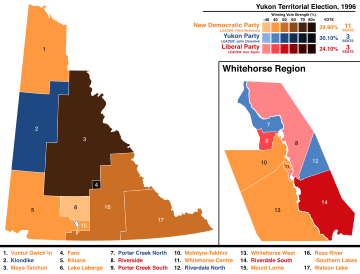1996 Yukon general election facts for kids
|
|||||||||||||||||||||||||||||||||||||||||||||
|
17 seats of the Yukon Legislative Assembly 9 seats needed for a majority |
|||||||||||||||||||||||||||||||||||||||||||||
|---|---|---|---|---|---|---|---|---|---|---|---|---|---|---|---|---|---|---|---|---|---|---|---|---|---|---|---|---|---|---|---|---|---|---|---|---|---|---|---|---|---|---|---|---|---|
| Turnout | 79.6% | ||||||||||||||||||||||||||||||||||||||||||||
|
|||||||||||||||||||||||||||||||||||||||||||||

Popular vote by riding. As this is an FPTP election, seat totals are not determined by popular vote, but instead by the result in each riding. Riding names are listed at the bottom.
|
|||||||||||||||||||||||||||||||||||||||||||||
|
|||||||||||||||||||||||||||||||||||||||||||||
The 1996 Yukon general election took place on September 30, 1996. People in the Yukon Territory, Canada, voted to choose 17 members for the Yukon Legislative Assembly. This assembly is like a parliament for the Yukon.
The Yukon Party, which was the government at the time, lost the election. The New Democratic Party (NDP) won instead. The NDP is a party that believes in social democracy, focusing on fairness and public services. They won 11 seats, which was enough to form a majority government. This means they had more than half the seats.
After the election, the leader of the NDP, Piers McDonald, became the new Government Leader. The Yukon Party and the Yukon Liberal Party each won three seats. The Liberal Party is a centrist party, meaning they are often in the middle of political ideas. Even though his party won seats, the Liberal leader, Ken Taylor, did not win his own seat.
Contents
Understanding the Election Results
An election is how people choose their leaders. In the Yukon, voters pick someone to represent them in the Legislative Assembly. The party that wins the most seats usually forms the government.
How Parties Performed
Here's a look at how each main party did in the 1996 election:
- The New Democrats (NDP) were led by Piers McDonald. They had 16 candidates running. They won 11 seats, which was 5 more than they had before. They received 39.9% of all votes.
- The Yukon Party was led by John Ostashek. They had 15 candidates. They won only 3 seats, losing 4 seats from the previous election. They got 30.1% of the votes.
- The Liberal Party was led by Ken Taylor. They had 16 candidates. They won 3 seats, which was 2 more than they had before. They received 24.1% of the votes.
- Some candidates ran as Independents, meaning they did not belong to a specific party. They had 7 candidates but did not win any seats. They received 5.9% of the votes.
In total, 17 seats were available in the Legislative Assembly. The NDP won enough seats to form a majority government.
Changes in Members
Sometimes, members of the Legislative Assembly change between elections. This can happen if someone resigns or passes away.
- Esau Schafer from the Yukon Party was elected in a special by-election. This happened after the previous member, Johnny Able, passed away.
- David Sloan from the NDP was also elected in a by-election. This was after the former premier, Tony Penikett, resigned.
- Alan Nordling rejoined the Yukon Party before this election.
Images for kids


